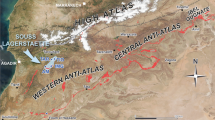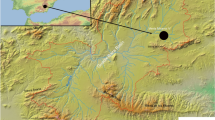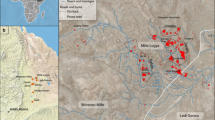Abstract
THE prolific abundance of fossils in the sediments of the Tethyan (or Tibetan) Himalayas and their reported absence in the pre-Tertiary sediments of the Lower Himalayas have been explained time and again by envisaging a highland1, a geanticline2 or a ridge3 between the two basins. This difference has also been explained by proposing a vast distance4 between the two basins, on the basis of palaeomagnetic data5. The use of palaeomagnetic data in the studies of global tectonics has, however, been convincingly challenged by Meyerhoff6, who further states that the present geographical relation of India with Asia has been constant since middle Proterozoic times. Whether or not the Himalayas originated as a consequence of continental drift7 remains undecided. But we can now provide evidence that the Lower Himalayas are not as barren of fossils as has been supposed8. Maybe there is no need to postulate a physical barrier between the Tethyan and the Lower Himalayan Basins. Recent discoveries of algal structures9,10 and coccolithophorids11 from the Krols are also important in this context.
This is a preview of subscription content, access via your institution
Access options
Subscribe to this journal
Receive 51 print issues and online access
$199.00 per year
only $3.90 per issue
Buy this article
- Purchase on Springer Link
- Instant access to full article PDF
Prices may be subject to local taxes which are calculated during checkout
Similar content being viewed by others
References
West, W. D., Curr. Sci., 289 (1935).
Wadia, D. N., Geology of India, 420 (Macmillan, London, 1966).
Fuchs, G., Twenty-third Intern. Geol. Cong., 3, 168 (1968).
Jain, S. P., and Kanwar, R. C., Nature, 227, 829 (1970).
Holmes, A., Principles of Physical Geology, 1224 (Nelson, London, 1965).
Meyerhoff, A. A., J. Geol., 78, 44, 6 (1970).
Gansser, A., Eclogae Geol. Helv., 59, 844 (1966).
Valdiya, K. S., Twenty-second Intern. Geol. Cong., 11, 16 (1964).
Bhargava, O. N., Bull. Indian Geol. Assoc., 2, 120 (1969).
Kumar, S., Geol. Mag., 107, 191 (1970).
Tewari, B. S., Bull. Indian Geol. Assoc., 2, 122 (1969).
Auden, J. B., Rec. Geol. Survey India, 67, 382, 383, 385, 391 (1934).
Cloud, jun., P. E., Organic Geochemistry, 732, 733 (Springer, Berlin, Heidelberg, 1969).
Geol. Survey India News, 1, 10 (1970).
Author information
Authors and Affiliations
Rights and permissions
About this article
Cite this article
PATWARDHAN, A., AHLUWALIA, A. Discovery of Pre-tertiary Fossils indigenous to the Lower Himalayan Basin. Nature 230, 451–452 (1971). https://doi.org/10.1038/230451a0
Received:
Issue Date:
DOI: https://doi.org/10.1038/230451a0
This article is cited by
-
More evidence in favour of the biochemical origin of the Mussoorie phosphorite, Kumaon Lower Himalaya, India
Mineralium Deposita (1975)
Comments
By submitting a comment you agree to abide by our Terms and Community Guidelines. If you find something abusive or that does not comply with our terms or guidelines please flag it as inappropriate.



